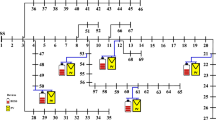Abstract
The optimal operation of current distribution networks has a great importance due to growing electrical demand and significant power losses. In this paper, the optimal allocation of unified power quality conditioner (UPQC) in smart grid with responsive loads is investigated as an appropriate solution to reduce power losses. Also, in order to consider different consumption patterns and to predict the demand with the lowest error, different linear and nonlinear models of responsive loads are taken into account. New pricing method in demand response programs (DRPs) is another concept which is developed in the paper by which optimal electricity prices in DRP during peak, off-peak, and valley periods are determined. Moreover, DRPs are prioritized by the Topsis method based on the different Utility’s policies. The final proposed model has been applied on the IEEE 12-bus, IEEE 33-bus, and the practical 94-bus Portuguese RDS distribution system. The results show that the UPQC allocation in the presence of DRPs is a win–win game both for the Utility and for customers.












Similar content being viewed by others
Abbreviations
- CL i :
-
Proximity to the ideal option
- D :
-
Decision matrix
- E(.):
-
Element of the price elasticity matrix
- H :
-
Harmonic order
- I h j :
-
jth bus current in the hth harmonic
- I h :
-
Buses injected current for the hth harmonic
- I L :
-
Load current
- I L(.):
-
Load current of each bus
- I fL :
-
Main components of the load current
- I lk :
-
Current in each branch
- I Sh :
-
Injected current of the shunt inverter
- I s :
-
Current source
- N Branch :
-
Number of the network branches
- N Bus :
-
Number of buses
- Nh:
-
Number of harmonic order
- N line :
-
Number of lines
- N load :
-
Number of loads
- \( {\text{NSI}}_{a} \) :
-
Network security index
- P Se :
-
Active power of series inverter
- P sh :
-
Active power of shunt inverter
- Q Se :
-
Reactive power of series inverter
- Q sh :
-
Reactive power of shunt inverter
- \( Q_{\text{L}}^{ '} \left( i \right) \) :
-
Reactive power demand for the ith bus
- Q iSe :
-
Injected reactive power of the series inverter in the ith bus
- RPLoss :
-
Real loss
- S Sh :
-
Steady-state capacity of the shunt inverter
- S se :
-
Series inverter’s capacity
- T :
-
Total time period
- THDL :
-
Total harmonic distortion of the load current
- V se :
-
Voltage of the series inverter
- V S :
-
Voltage source
- V DL :
-
Appropriate load voltage
- V L :
-
Load voltage
- V S :
-
Source voltage
- V h j :
-
jth bus voltage in the hth harmonic
- V h :
-
Buses voltage vectors for the hth harmonic
- LODF:
-
Line outage distribution factor
- V 1 j :
-
Magnitude of the jth bus in the main frequency
- V h j :
-
Voltage magnitude of the jth bus in the hth harmonic
- \( {\text{VSF}}_{a} \) :
-
Voltage stability index
- Y h :
-
Admittance matrix for the hth harmonic
- α i :
-
Phase angle before the UPQC allocation
- d max(.):
-
Maximum demand during T
- d min(.):
-
Minimum demand during T
- d max0 (.):
-
Maximum initial demand during T
- d min0 (.):
-
Minimum initial demand during T
- d lin(.):
-
Linear load model
- d pot (.):
-
Potential load model
- d exp (.):
-
Exponential load model
- d log(.):
-
Logarithmic load model
- d 0(.):
-
Initial demand before DRPs implementation
- d − i :
-
Distance between the option i and the negative ideal option
- d + i :
-
Distance between the option i and the positive ideal option
- \( {\text{inc}}\left( {t^{{\prime }} } \right) \) :
-
Incentive at the tth hour
- k :
-
Index of the transfer bus for the lkth bus
- loss0(.):
-
Initial loss
- loss(.):
-
Loss after DRPs
- l :
-
Index of the receiver bus for the lkth bus
- n ij :
-
jth element of the matrix D
- \( {\text{pen}}\left( {t^{{\prime }} } \right) \) :
-
Penalty at the tth hour
- r(lk):
-
Resistance of the lkth branch
- r ij :
-
Gain obtained by the option i in the criterion
- Z(lk):
-
Impedance of the lkth branch
- ρ(.):
-
Electricity price after the optimal pricing
- ρ 0(.):
-
Initial electricity price
- θ se :
-
Angle between the source voltage and series inverter
- θ sh :
-
Angle between the source voltage and shunt inverter
- δ i :
-
Angle between the load voltage the source voltage in the ith bus
- φ :
-
Angle between the voltage and the load current
- δ :
-
Angle between the load voltage and the voltage source
- A/S:
-
Ancillary services market
- CAP:
-
Capacity market
- CPP:
-
Critical peak pricing
- CSA:
-
Cuckoo search algorithm
- DB:
-
Demand bidding
- DE:
-
Differential evolution
- DED:
-
Dynamic economic dispatch
- DFACTS:
-
Distributed flexible AC transmission system
- DGs:
-
Distributed generations
- DLC:
-
Direct load control
- DPTV:
-
Deviation of peak to valley
- DRPs:
-
Demand response programs
- DSM:
-
Demand-side management
- DSTATCOM:
-
Distribution static compensator
- DVR:
-
Dynamic voltage restorer
- EDRP:
-
Emergency demand response program
- ESSs:
-
Energy storage systems
- GLODF:
-
Generalized line outage distribution factor
- ICA:
-
Imperialist competitive algorithm
- I/C:
-
Interruptible/curtailable service
- LF:
-
Load factor
- ISO:
-
Independent system operator
- MCDM:
-
Multi-criteria decision-making
- MIP:
-
Mixed integer programming
- MOSOA:
-
Multi-objective seeker-optimization-algorithm
- PC:
-
Peak compensate
- PDR/PTR:
-
Peak day rebates/peak time rebates
- PEM:
-
Price elasticity matrix
- PLP:
-
Peak load pricing
- PQ:
-
Power quality
- PSO:
-
Particle swarm optimization
- PTV:
-
Peak to valley
- RESs:
-
Renewable energy sources
- RTP:
-
Real-time pricing
- SG:
-
Smart grid
- TCPST:
-
Thyristor-controlled phase shifting transformer
- TCSC:
-
Thyristor-controlled series capacitor
- THD:
-
Total harmonic distortion
- TOU:
-
Time of use
- UPQC:
-
Unified power quality conditioner
- VGC:
-
Vickrey–Clarke–Groves
References
Biscaro AAP, Pereira RAF, Kezunovic M, Mantovani JRS (2016) Integrated fault location and power-quality analysis in electric power distribution systems. IEEE Trans Power Deliv 31:428–436
Fergany EI, Attia A (2013) Optimal capacitor allocations using evolutionary algorithms. IET Gener Transm Distrib 7:593–601
Taher SA, Afsari SA (2014) Optimal location and sizing of DSTATCOM in distribution systems by immune algorithm. Int J Electr Power Energy Syst 60:34–44
Jazebi S, Hosseinian SH, Vahidi B (2011) DSTATCOM allocation in distribution networks considering reconfiguration using differential evolution algorithm. Energy Convers Manag 52:2777–2783
Vinod K (2012) Enhancing electric power quality using UPQC: a comprehensive overview. IEEE Trans Power Electron 27:2284–2297
Josep M, Guerrero M (2017) Guest editorial special issue on power quality in smart grids. IEEE Trans Smart Grid 8:379–381
Bahrami S, Wong V, Huang J (2018) Data center demand response in deregulated electricity markets. IEEE Trans Smart Grid 10(3):2820–2832
Amini MH (2019) demand response in future power networks: panorama and state-of-the-art. In: sustainable interdependent networks, Springer, Berlin, pp 167–191
Aalami HA, Moghaddam MP, Yousefi GR (2010) Modeling and prioritizing demand response programs in power markets. Electr Power Syst Res 80:426–435
Aalami HA, Moghaddam MP, Yousefi GR (2015) Evaluation of nonlinear models for time-based rates demand response programs. Int J Electr Power Energy Syst 65:282–290
Jordehi AR (2015) Particle swarm optimization (PSO) for allocation of FACTS devices in electric transmission systems: a review. Renew Sustain Energy Rev 52:1260–1267
Jordehi AR (2016) Optimal allocation of FACTS devices for static security enhancement in power systems via imperialistic competitive algorithm (ICA). Appl Soft Comput 48:317–328
Devi S, Geethanjali M (2014) Optimal location and sizing determination of distributed generation and DSTATCOM using particle swarm optimization algorithm. Int J Electr Power Energy Syst 62:562–570
Hajar Bagheri T, Hasan Ali M, Rizwan M (2015) Simultaneous reconfiguration, optimal placement of DSTATCOM, and photovoltaic array in a distribution system based on fuzzy-ACO approach. IEEE Trans Sustain Energy 6:210–218
Kumar D, Samantaray SR (2016) Implementation of multi-objective seeker-optimization-algorithm for optimal planning of primary distribution systems including DSTATCOM. Int J Electr Power Energy Syst 77:439–449
Sirjani R, Rezaee Jordehi A (2017) Optimal placement and sizing of distribution static compensator (D-STATCOM) in electric distribution networks: a review. Renew Sustain Energy Rev 77:688–694
Jayanti S, Goswami SK (2016) Optimal location of unified power quality conditioner in distribution system for power quality improvement. Int J Electr Power Energy Syst 83:309–324
Ganguly S (2014) Impact of unified power-quality conditioner allocation on line loading, losses, and voltage stability of radial distribution systems. IEEE Trans Power Deliv 29:1859–1867
Ganguly S (2014) Multi-objective planning for reactive power compensation of radial distribution networks with unified power quality conditioner allocation using particle swarm optimization. IEEE Trans Power Syst 29:1801–1810
Ganguly S (2014) Unified power quality conditioner allocation for reactive power compensation of radial distribution networks. IET Gener Transm Distrib 8:1418–1429
Li N, Chen L, Low SH (2011) Optimal demand response based on utility maximization in power networks. In: Power and energy society general meeting, IEEE. San Diego, CA, pp 24–29
Aghaei J, Alizadeh MI (2013) Demand response in smart electricity grids equipped with renewable energy sources: a review. Renew Sustain Energy Rev 18:64–72
Yousefi A, Nguyen TT, Zareipour H, Malik OP (2012) Congestion management using demand response and FACTS devices. Electr Power Energy Syst 37:78–85
Nguyen DH, Narikiyo T, Kawanishi M (2017) Optimal demand response and real-time pricing by a sequential distributed consensus-based ADMM approach. IEEE Trans Smart Grid 9(5):4964–4974. https://doi.org/10.1109/TSG.2017.2676179
Dehnavi E, Abdi H (2016) Optimal pricing in time of use demand response by integrating with dynamic economic dispatch problem. Energy 109:1086–1094
Abdel-Akher M (2013) Voltage stability analysis of unbalanced distribution systems using backward/forward sweep load-flow analysis method with secant predictor. IET Gener Transm Distrib 7:309–317
Kayal P, Chanda CK (2015) Optimal mix of solar and wind distributed generations considering performance improvement of electrical distribution network. Renew Energy 75:173–186
Varadarajan M, Swarup KS (2008) Differential evolutionary algorithm for optimal reactive power dispatch. Electr Power Syst Res 30:435–441
Acharjee P (2016) Optimal power flow with UPFC using security constrained self-adaptive differential evolutionary algorithm for restructured power system”. Int J Electr Power Energy Syst 76:69–81
Jazebi S, Vahidi B (2012) Reconfiguration of distribution networks to mitigate utilities power quality disturbances. Electr Power Syst Res 91:9–17
Vardakas JS, Zorba N, Verikoukis CV (2015) A survey on demand response programs in smart grids: pricing methods and optimization algorithms. IEEE Commun Surv Tutor 17:152–178
Dehanvi E, Abdi H (2016) Determining the optimal buses for implementing demand response as an effective congestion management method. IEEE Trans Power Syst 99:1537–1544
Abdi H, Dehnavi E, Mohammadi F (2015) Dynamic economic dispatch problem integrated with demand response (DEDDR) considering non-linear responsive load models. IEEE Trans Smart Grid 99:2586–2595
Ghasemi-Falavarjani S, Nematbakhsh MA, Shahgholi Ghahfarokhi B (2015) Context-aware multi-objective resource allocation in mobile cloud. Comput Electr Eng 44:218–240
Sengul U, Eren M, Eslamian Shiraz SH, Gezder V, Bilal Sengul A (2015) Fuzzy TOPSIS method for ranking renewable energy supply systems in Turkey. Renew Energy 75:617–625
Baran ME, Wu FF (1989) Network reconfiguration in distribution systems for loss reduction and load balancing. IEEE Trans Power Delivery 4:1401–1409
Das D, Nagi HS, Kothari DP (1994) Novel method for solving radial distribution networks. IEE Proc Gener Transm Distrib 141:291–298
Zeinalzadeh A, Mohammadi Y, Moradi MH (2015) Optimal multi objective placement and sizing of multiple DGs and shunt capacitor banks simultaneously considering load uncertainty via MOPSO approach. Electr Power Energy Syst 67:336–349
Esmaeilian HR, Fadaeinedjad R (2013) Optimal reconfiguration and capacitor allocation in unbalanced distribution network considering power quality issues. In: 22nd International conference and exhibition on electricity distribution (CIRED 2013), Stockholm, Sweden, IET
Author information
Authors and Affiliations
Corresponding author
Additional information
Publisher's Note
Springer Nature remains neutral with regard to jurisdictional claims in published maps and institutional affiliations.
Appendix
Appendix
See Table 3.
Rights and permissions
About this article
Cite this article
Dehnavi, E., Afsharnia, S. & Gholami, K. Optimal allocation of unified power quality conditioner in the smart distribution grids. Electr Eng 101, 1277–1293 (2019). https://doi.org/10.1007/s00202-019-00861-2
Received:
Accepted:
Published:
Issue Date:
DOI: https://doi.org/10.1007/s00202-019-00861-2




